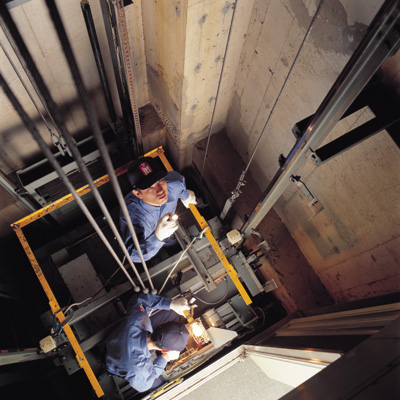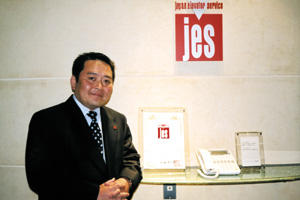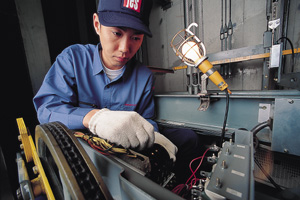Intelligent Elevators
Back to Contents of Issue: September 2004
|
|
|
|
by John Dodd |
|
 THERE ARE AN ESTIMATED 244,000 elevators in the Kanto region. Elevators in Japan are traditionally serviced by the manufacturer, but 10 years ago, an ambitious entrepreneur decided to challenge the status quo and take a small share for himself. 38-year old Katsushi Ishida has used technology, competitive pricing and good old-fashioned quality of sales to wrest almost 5 percent of the market away from the majors. Ishida is now picking up the pace and is targeting 10 percent in the next three years. We interviewed him to discover how he was able to wedge himself into this very closed industry. THERE ARE AN ESTIMATED 244,000 elevators in the Kanto region. Elevators in Japan are traditionally serviced by the manufacturer, but 10 years ago, an ambitious entrepreneur decided to challenge the status quo and take a small share for himself. 38-year old Katsushi Ishida has used technology, competitive pricing and good old-fashioned quality of sales to wrest almost 5 percent of the market away from the majors. Ishida is now picking up the pace and is targeting 10 percent in the next three years. We interviewed him to discover how he was able to wedge himself into this very closed industry.How did you get started? I founded JES, which stands for Japan Elevator Services, in 1994. Originally I was a maintenance engineer, working on the repairs and technology side of the business. During that training period, I acquired certification as an elevator inspector. After that I did sales and business development for my employer. Then I founded this company. I started out by myself, doing both maintenance and sales -- I'd pop on a business suit after a job to get new clients, and grew the company organically. Today we have 140 employees, 11 branches in Tokyo and three Kanto prefectures, and in Sapporo, Hokkaido. We also have about 6,000 contract customers and we are growing 30 percent a year. Our sales revenue last year was about \1.5 billion and will be \2 billion by the end of this fiscal year (ending September, 2004). 30 percent a year puts you among the fastest growing companies in Japan. What is your overall ranking in the industry? We are No. 2 among the third-party elevator maintenance companies. My main competitor, and the company I once worked for, has 1 percent greater market share than we do, so I'm hoping to overtake them in the next year or so. After that, my target is to take on some of the manufacturers. How big is the third-party maintenance industry? There are 50 to 60 players in the market, and most of them have less than 1,000 contract customers -- indeed, many are "mom and pop"-type operations. With companies like my own able to offer competitive pricing and technology-based services, these smaller companies are unable to grow much. Basically elevator customers like building owners and managers prefer the safety and security of a larger provider, but they don't always want to be tied to the original manufacturer because there is no price competition. With our size and experience, we are attractive to such customers. Who is Number One? A company called SEC. What is your company's biggest selling point? There are three, and they are basically simple. We're "third party," so we compete on price with the actual manufacturers. We're 30 to 40 percent cheaper -- but using genuine specifications and parts, we're innovative and give customers reporting and monitoring services that no one else has. And we're big enough that we're reliable and have the resources. How do you price 30 percent lower than a manufacturer while still using their parts? Well, you need to remember the Japanese way of doing business. The manufacturers will often sell an elevator at little margin or even at a loss in order to win a contract. Then they hope to pick up the profits on the maintenance side of the business. Kind of like a 'razors-and-razor-blades' business model. This worked fine while the manufacturer could control who could buy their spare parts, but in the last 15 years, the laws on fair trade have changed dramatically. Now companies like mine can get access to the parts and service manuals. And of course, I don't have the research and development costs of a manufacturer, so this works well for us. The requirement to sell you parts must stick in the craw of the manufacturers. Yes, they don't like it, but they were forced by a Shikoku company about 15 years ago, in quite a famous antimonopoly lawsuit, to supply parts to third party maintenance companies. The Shikoku company's legal premise was that elevators are usually sold, not operated on leases, and therefore the owners had the right to engage any suitably qualified party to maintain their product. In view of this argument, the judge said it was inevitable that the manufacturers had to be supply spare parts as the product wore out. The case opened up the market. Of course, the problem now is that the manufacturers are often slow to deliver and can put us in a difficult situation. Just the year before last, the Fair Trade Commission investigated Mitsubishi for purposefully slow delivery -- I must say that their service improved dramatically after that! In any case, we made it a rule to keep parts in inventory, so that we cannot be held hostage in the future.  Are you tempted to use imported or third party spare parts?
Are you tempted to use imported or third party spare parts?Maybe at some point in the future, but right now the strategy is to only use branded parts and thus reduce any hurdle to customers considering buying our service. This point really works and is a major contributor to our success in pulling in 6,000 customers. So if you're using the same parts, then the selling focus is on quality of service? Price, speed of response, monitoring and diagnostics technology, and flexibility. How do you offer better response times? We have a sophisticated tracking system for our engineers, and a 24-hour call center with the latest customer queuing and data-tracking technology. Tell us more about the engineer tracking system. This system is unique in the industry. Every engineer has a GPS cell phone, so we know exactly where they are. When we get a customer call, we check the engineer's actual location and their schedule, then give the customer an on-the-spot estimate of the engineer's attendance time. After that, we check in with the engineer to confirm the time and make a follow-up customer call if necessary. Using this system we can give customers apparent real-time feedback, while not bothering our engineers incessantly when they are in the middle of some delicate adjustments or tests. We've always wondered what would happen if you got stuck in an elevator during an earthquake or fire. Well, as you probably know, the elevator moves to battery power and tries to move to the nearest floor to exit. But what if the elevator gets stuck between floors? That's always a possibility. Well, apart from the intercom in each elevator, in almost all newer buildings -- that is, those building constructed within the last 10 years -- elevators come fitted with sensors to detect whether they are operating normally or not. We can also retrofit these sensors. Then, in the event of some problem, including a natural disaster such as an earthquake or a fire, our Monitoring Center is alerted. We have a well-drilled team, and their response in the event of a natural disaster is to cover their region and help customers out of difficulty. Hospitals and government offices have the highest priority in an emergency. And, I'm proud to say that our company has a contract with the Finance Ministry and the Defense Agency, so we go to their offices first. For the hospitals, we have established evacuation procedures for emergencies. Further, on some of the most recently constructed buildings, we have the ability to remotely control the elevator. In case of power failure, how do you move the elevators? As I said before, elevators have emergency batteries. Maintaining these emergency systems, including topping up the electrolyte in the batteries, is part of our normal service procedure. Maintaining elevators seems to be associated with risk management. Are third-party liability insurance premiums expensive? Spread out over 6,000 contracts, the premiums are reasonable: about \1 billion per year. Hopefully you'll never need to use that insurance. We have an excellent safety record. In ten years of operation, we've never had a serious injury, among either our engineers or customers caught in an elevator. We're very strict about training for employee safety. And the quality and completeness of our maintenance procedures are equal to or better than other major players. We even have a manual for crisis management, just in case our backup systems fail. You mentioned previously that you are able to remotely control and monitor the elevators. Is this something new in the industry? Yes, we've been putting technology to work, reducing our costs and thus the costs to the owners. But you can't skimp on testing, so we are trying to automate the process as much as possible. Actually, I believe that we're the only third-party maintenance company to be able to conduct remote inspections and monitoring. We control the target elevators by entering instructions from an operator keyboard here at our Network Operating Center. What control and feedback can you get remotely? On some of the newer elevators, we can see how many times the door has opened, what speed it is moving at, how much electricity it is currently using -- things like that. So when the data points exceed preset ranges, the system signals an alarm to our operators. We've invested aggressively in our technology and now lead the industry in terms of actual application of systems and feedback into an integrated customer service. We can provide clients with substantially more detailed reports and warnings of impending maintenance even while not having to attend the actual site as often -- thus keeping costs down and service levels up.  As an indication of our standing in the marketplace, we were recently visited by a major elevator manufacturer that had heard about us. In this rather conservative industry, such a visit is unusual, especially to a "lowly" third party vendor. They wanted to know all about our system and how it works. When we showed it to them, they were very surprised. They said that we had effectively eliminated their competitive advantage, and at a distinctly lower price.
As an indication of our standing in the marketplace, we were recently visited by a major elevator manufacturer that had heard about us. In this rather conservative industry, such a visit is unusual, especially to a "lowly" third party vendor. They wanted to know all about our system and how it works. When we showed it to them, they were very surprised. They said that we had effectively eliminated their competitive advantage, and at a distinctly lower price.You must be getting to a size that investors are taking notice. Your company is private, correct? Yes, we're private, and I don't plan to take us public for a while yet. However, it is true that we're attracting the attention of investors, and approaches from both domestic and foreign firms are starting to pick up. Indeed, we recently even had an M&A offer from a major foreign player. Why is that? The reasons for the interest are obvious: we're growing and yet making money at the same time. Our growth rate is roughly 160 new contracts per month, which is roughly 2,000 new contracts a year. At this rate, we will have passed our major competitor within the next two years, and will have about 10 percent of the market over the next 10 years. This means, of course, that the manufacturers will lose at least 10 percent of their market share and most likely significantly more than that -- possibly even up to 50 percent, if you take all the other third-party maintenance companies also trying to gain market share. So buying us out would not only remove a major threat but also bring in new technology. Their only problem is that I don't want to sell. Indeed, at some point, I may even go into manufacturing myself. If you don't plan to sell, what is the plan then? Grow the business into a major player, and eventually become a manufacturer myself. We have been looking at the feasibility of doing the production in China, to our specification. To get such a strategy kicked off, I'm already making enquiries into making some non-critical materials, such as elevator facades as a practice run. So you want to be a manufacturer then. What share of the market do the manufacturers currently occupy? Right now, about 90 percent. Approximately 28,000 contracts, or a bit under 10 percent, are held by SEC and JES. The ultimate test of your credibility is your client list. Do you have any notable clients? Yes, of course. We maintain the elevators at the Tokyo Metropolitan Subway Station, the head office of the Meteorological Agency, the Defense Agency, Ministry of Finance, Japan Tobacco's Shibuya office, Nikkei Newspaper and Nikkei BP, the headquarters of Higashi Nippon Bank, and Fujitsu. It's a pretty good list. What is the typical contract value for a single elevator in a multi-story building such as the Kokusai Building in Toranomon? I would guess about \500,000 a year, \40,000 per month, for the inspection and maintenance, not including parts, for one elevator. So if a building has eight to ten elevators, the cost would be about \5 million. Well, the price goes down with volume, and up when the building is a high-rise. To give you some idea, and I don't remember how many elevators they have, but the maintenance fee for the Sumitomo Triangle Building in Shinjuku is well over \100 million per year. Until now you have mainly been focusing on smaller buildings, rather than 'special needs' high rises. What is your next target? We would like to start doing more business with foreign real estate investment and property management firms. We can offer excellent pricing, service, and reporting -- basically everything foreign firms need to support their global service levels, and profit and reporting requirements. Do you have any plans for overseas expansion? I am interested in the China market and have already done some preparatory work in Shanghai. The great thing about China is that it is going all out to prepare for the 2008 Olympic games. They have to build a tremendous amount of infrastructure yet, and I'd like to be part of that. Also, being a Japanese firm confers a feeling of quality and excellent customer service. For this reason, I've already had a number of approaches from China-based firms wanting to tie up in some way. @ |
|
Note: The function "email this page" is currently not supported for this page.





